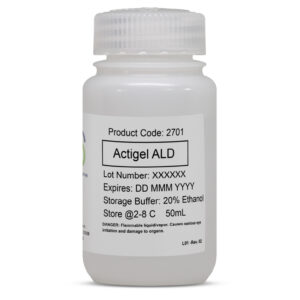Table 1. Resin Characteristics
| Bead Material
| Agarose |
| Bead Percentage
| 4% |
| Bead Size | 60-160 µm |
| Flow Rate1 | >20 mL/min (>1020 cm/hr) @ 25oC |
| pH Stability2 | 2-9 |
| Storage Temperature | 2-8o C |
| Storage Buffer
| 100% Anhydrous Isopropanol (IPA) |
| Form | Slurry |
| Chemical Stability2 | Stable in all commonly used aqueous solutions and buffers. |
| Physical Stability2 | Negligible volume variation due to changes in pH or ionic strength. |
1Linear flow rate = volumetric flow rate (cm3/h)/column cross-sectional area (cm2)
2Data refer to the coupled product, provided that the ligand can withstand the pH or chemical environment. Please note the following: pH stability, long term refers to the pH interval where the medium is stable over a long period of time without adverse effects on its subsequent chromatographic performance. pH stability, short term refers to the pH interval for regeneration and cleaning procedures.
Instructions for Use
NHS Activated Superflow 4 is a resin used for the immobilization of peptides, proteins, and
other small biological species. The process couples these bio -specific molecules to an activated
media to create a chemically stable amide bond(s).
Coupling Protocol
Reagents:
Coupling Buffer: 0.1M NaHCO3, 0.5M NaCl, pH = 8.3
Blocking Buffer: 0.5M ethanolamine 0.5M NaCl, pH = 8.3
High pH Buffer: 0.1M Tris-HCl, pH = 8.5
Low pH Buffer: 0.1M NaCH3COO, 0.5M NaCl, pH = 4.5
1. Prepare the coupling solution by adding the desired ligand to the coupling buffer.
2. Wash the NHS Activated Superflow 4 resin with 10-15 bed volumes (BV) of cold 1mM
HCl immediately before use.
3. Mix the washed media and the coupling solution.
4. Adjust the pH to the desired coupling level (~pH = 8.3).
5. Allow the reaction to mix/rock for 4 hours at room temperature.
A. If the coupling is performed at 4oC, it can be left overnight.
6. After the coupling is complete, add blocking buffer to the reaction solution.
7. Allow to mix/rock for 2 hours.
8. Once the blocking step is finished, the resin can be washed.
9. Wash media using alternating pH buffers (high pH and low pH).
10. Start by adding 1 BV of high pH buffer to the coupled resin and mix for 1-2 minutes.
11. Pour off solution and suction dry to remove residual high pH buffer.
12. Add 1 BV of low pH buffer and mix for 1-2 minutes.
13. Pour off solution and suction dry to remove residual low pH buffer.
14. Repeat steps 10-13 (5 additional times).
15. Store resin in 20% ethanol.






